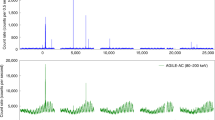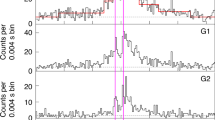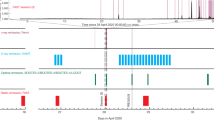Abstract
Magnetars are young, magnetically powered neutron stars that possess the strongest magnetic fields in the Universe. Fast radio bursts (FRBs) are extremely intense millisecond-long radio pulses of primarily extragalactic origin, and a leading attribution for their genesis focuses on magnetars. A hallmark signature of magnetars is their emission of bright, hard X-ray bursts of sub-second duration. On 27 April 2020, the Galactic magnetar SGR J1935+2154 emitted hundreds of X-ray bursts within a few hours. One of these temporally coincided with an FRB, the first known detection of an FRB from the Milky Way. Here, we present spectral and temporal analyses of 24 X-ray bursts emitted 13 hours prior to the FRB and seen simultaneously with the Neutron Star Interior Composition Explorer (NICER) mission of the National Aeronautics and Space Administration and with the Fermi Gamma-ray Burst Monitor (GBM) mission in their combined energy range of 0.2 keV to 30 MeV. These broadband spectra permit direct comparison with the spectrum of the FRB-associated X-ray burst (FRB-X). We demonstrate that all 24 NICER and GBM bursts are very similar temporally to the FRB-X, but strikingly different spectrally. The singularity of the FRB-X burst is perhaps indicative of an uncommon locale for its origin. We suggest that this event originated in quasi-polar open or closed magnetic field lines that extend to high altitudes.
This is a preview of subscription content, access via your institution
Access options
Access Nature and 54 other Nature Portfolio journals
Get Nature+, our best-value online-access subscription
$29.99 / 30 days
cancel any time
Subscribe to this journal
Receive 12 digital issues and online access to articles
$119.00 per year
only $9.92 per issue
Buy this article
- Purchase on Springer Link
- Instant access to full article PDF
Prices may be subject to local taxes which are calculated during checkout



Similar content being viewed by others
Data availability
NICER raw data and cleaned Level 2 data files were generated at the Goddard Space Flight Center large-scale facility. These data files, with observation ID 3020560101, can be found at https://heasarc.gsfc.nasa.gov/FTP/nicer/data/obs/2020_04/3020560101. Fermi GBM data files were generated at the Marshall Space Flight Center large-scale facility, and can be found at https://heasarc.gsfc.nasa.gov/FTP/fermi/data/gbm/daily/2020/04/28/current. Level 3 data that support the findings of this study are available from the corresponding authors upon request. Source data are provided with this paper.
Code availability
Reduction and analysis of the data were conducted using publicly available codes provided by the High Energy Astrophysics Science Archive Research Center, which is a service of the Astrophysics Science Division at the NASA Goddard Space Flight Center and of the High Energy Astrophysics Division of the Smithsonian Astrophysical Observatory. For NICER, NICERDAS version 7a, which is part of HEASoft 6.27.2 (https://heasarc.gsfc.nasa.gov/docs/software/lheasoft), was used. Fermi tools version 1.0.3 and GSpec version 0.9.1 were used for the analysis of Fermi GBM data (https://fermi.gsfc.nasa.gov/ssc/data/analysis/gbm/). Spectral analysis was conducted using Xspec version 12.11.0 (https://heasarc.gsfc.nasa.gov/docs/xanadu/xspec/). Custom codes used to create plots presented in this manuscript are available from the corresponding authors upon request. These used Python libraries NumPy42, SciPy43 and Matplotlib44. Source data are provided with this paper.
References
Kouveliotou, C. et al. An X-ray pulsar with a superstrong magnetic field in the soft γ-ray repeater SGR1806 – 20. Nature 393, 235–237 (1998).
Kouveliotou, C. et al. Discovery of a magnetar associated with the soft gamma repeater SGR 1900+14. Astrophys. J. Lett. 510, L115–L118 (1999).
Israel, G. L. et al. The discovery, monitoring and environment of SGR J1935+2154. Mon. Not. R. Astron. Soc. 457, 3448–3456 (2016).
Younes, G. et al. X-Ray and radio observations of the magnetar SGR J1935+2154 during Its 2014, 2015, and 2016 outbursts. Astrophys. J. 847, 85 (2017).
Lin, L. et al. Burst properties of the most recurring transient magnetar SGR J1935+2154. Astrophys. J. 893, 156 (2020).
Palmer, D. M. A forest of bursts from SGR 1935+2154. Astron. Telegr. No. 13675 (2020).
Younes, G. et al. NICER view of the 2020 burst storm and persistent emission of SGR 1935+2154. Astrophys. J. Lett. 904, L21 (2020).
Lin, L. et al. Fermi/GBM view of the 2019 and 2020 burst active episodes of SGR J1935+2154. Astrophys. J. Lett. 902, L43 (2020).
Borghese, A. et al. The X-Ray reactivation of the radio bursting magnetar SGR J1935+2154. Astrophys. J. Lett. 902, L2 (2020).
Gendreau, K. C. et al. The Neutron star Interior Composition Explorer (NICER): design and development. Proc. SPIE 9905, 99051H (2016).
Mereghetti, S. et al. INTEGRAL discovery of a burst with associated radio emission from the magnetar SGR 1935+2154. Astrophys. J. Lett. 898, L29 (2020).
Ridnaia, A. et al. A peculiar hard X-ray counterpart of a Galactic fast radio burst. Nat. Astron. https://doi.org/10.1038/s41550-020-01265-0 (2021).
Li, C. K. et al. Identification of a non-thermal X-ray burst with the Galactic magnetar SGR 1935+2154 and a fast radio burst with Insight-HXMT. Nat. Astron. https://doi.org/10.1038/s41550-021-01302-6 (2021).
The CHIME/FRB Collaboration. A bright millisecond-duration radio burst from a Galactic magnetar. Nature 587, 54–58 (2020).
Bochenek, C. D. et al. A fast radio burst associated with a Galactic magnetar. Nature 587, 59–62 (2020).
Lin, L. et al. Stringent upper limits on pulsed radio emission during an active bursting phase of the Galactic magnetar SGRJ1935+2154. Nature 587, 63–65 (2020).
Lorimer, D. R., Bailes, M., McLaughlin, M. A., Narkevic, D. J. & Crawford, F. A bright millisecond radio burst of extragalactic origin. Science 318, 777–780 (2007).
Thornton, D. et al. A population of fast radio bursts at cosmological distances. Science 341, 53–56 (2013).
Wadiasingh, Z. et al. The fast radio burst luminosity function and death line in the low-twist magnetar model. Astrophys. J. 891, 82 (2020).
Kouveliotou, C. et al. Identification of two classes of gamma-ray bursts. Astrophys. J. Lett. 413, L101–L104 (1993).
Lamb, D. Q. Surface and magnetospheric physics of neutron stars and gamma-ray bursts. AIP Conf. Proc. 77, 249–272 (1982).
Thompson, C. & Duncan, R. C. The soft gamma repeaters as very strongly magnetized neutron stars – I. Radiative mechanism for outbursts. Mon. Not. R. Astron. Soc. 275, 255–300 (1995).
Lin, L. et al. Fermi/Gamma-ray Burst Monitor observations of SGR J0501+4516 bursts. Astrophys. J. 739, 87 (2011).
Younes, G. et al. Time resolved spectroscopy of SGR J1550-5418 bursts detected with Fermi/Gamma-ray Burst Monitor. Astrophys. J. 785, 52 (2014).
Radhakrishnan, V. & Cooke, D. J. Magnetic poles and the polarization structure of pulsar radiation. Astrophys. J. Lett. 3, 225–229 (1969).
Thompson, C., Lyutikov, M. & Kulkarni, S. R. Electrodynamics of magnetars: implications for the persistent X-ray emission and spin-down of the soft gamma repeaters and anomalous X-ray pulsars. Astrophys. J. 574, 332–355 (2002).
Chen, A. Y. & Beloborodov, A. M. Particle-in-cell simulations of the twisted magnetospheres of magnetars. I. Astrophys. J. 844, 133 (2017).
Albano, A. et al. A unified timing and spectral model for the anomalous X-ray pulsars XTE J1810-197 and CXOU J164710.2-455216. Astrophys. J. 722, 788–802 (2010).
Bernardini, F. et al. Emission geometry, radiation pattern and magnetic topology of the magnetar XTE J1810-197 in its quiescent state. Mon. Not. R. Astron. Soc. 418, 638–647 (2011).
Younes, G. et al. Simultaneous magnetic polar cap heating during a flaring episode from the magnetar 1RXS J170849.0-400910. Astrophys. J. Lett. 889, L27 (2020).
Arzoumanian, Z. et al. The neutron star interior composition explorer (NICER): mission definition. Proc. SPIE 9144, 914420 (2014).
Wilson-Hodge, C. A. et al. NICER and Fermi GBM observations of the first Galactic ultraluminous X-ray pulsar swift J0243.6+6124. Astrophys. J. 863, 9 (2018).
Meegan, C. et al. The Fermi Gamma-ray Burst Monitor. Astrophys. J. 702, 791–804 (2009).
Gavriil, F. P., Kaspi, V. M. & Woods, P. M. A comprehensive study of the X-ray bursts from the magnetar candidate 1E 2259+586. Astrophys. J. 607, 959–969 (2004).
Arnaud, K. A. XSPEC: the first ten years. ASP Conf. Ser. 101, 17–20 (1996).
Wilms, J., Allen, A. & McCray, R. On the absorption of X-rays in the interstellar medium. Astrophys. J. 542, 914–924 (2000).
Verner, D. A., Ferland, G. J., Korista, K. T. & Yakovlev, D. G. Atomic data for astrophysics. II. New analytic fits for photoionization cross sections of atoms and ions. Astrophys. J. 465, 487 (1996).
Anderson, T. W. & Darling, D. A. A test of goodness of fit. J. Am. Stat. Assoc. 49, 765–769 (1954).
Hu, K., Baring, M. G., Wadiasingh, Z. & Harding, A. K. Opacities for photon splitting and pair creation in neutron star magnetospheres. Mon. Not. R. Astron. Soc. 486, 3327–3349 (2019).
Lu, W., Kumar, P. & Zhang, B. A unified picture of Galactic and cosmological fast radio bursts. Mon. Not. R. Astron. Soc. 498, 1397–1406 (2020).
Blaskiewicz, M., Cordes, J. M. & Wasserman, I. A relativistic model of pulsar polarization. Astrophys. J. 370, 643–669 (1991).
van der Walt, S., Colbert, S. C. & Varoquaux, G. The NumPy array: a structure for efficient numerical computation. Comput. Sci. Eng. 13, 22–30 (2011).
Virtanen, P. et al. SciPy 1.0: fundamental algorithms for scientific computing in Python. Nat. Methods 17, 261–272 (2020).
Hunter, J. D. Matplotlib: a 2D graphics environment. Comput. Sci. Eng. 9, 90–95 (2007).
Acknowledgements
A portion of this work was supported by the National Aeronautics and Space Administration (NASA) through the NICER mission and the Astrophysics Explorers Program. This research has made use of data and software provided by the High Energy Astrophysics Science Archive Research Center, which is a service of the Astrophysics Science Division at the NASA Goddard Space Flight Center and of the High Energy Astrophysics Division at the Smithsonian Astrophysical Observatory. G.Y. acknowledges support from NASA under NICER Guest Observer Cycle 1 program 2098 (grant no. 80NSSC19K1452). C.K. acknowledges support from NASA under Fermi Guest Observer Cycle 10 (grant no. 80NSSC17K0761). M.G.B. acknowledges the generous support from the National Science Foundation (grant no. AST-1813649). T.E. is supported by the Japan Society for the Promotion of Science and the Ministry of Education, Culture, Sports, Science and Technology (KAKENHI grant nos. 18H01246 and 18H04584) and by the RIKEN Hakubi project. S.G. acknowledges support from the French National Centre for Space Studies. W.C.G.H. acknowledges support from NASA (grant no. 80NSSC20K0278). NICER research at the United States Naval Research Laboratory is supported by NASA.
Author information
Authors and Affiliations
Contributions
G.Y. performed the data reduction and analysis and contributed to the writing of the manuscript. M.G.B. contributed to the theoretical interpretation of the results and to the writing of the manuscript. C.K. contributed to the interpretation of the results and to the writing of the manuscript. Z.A. is the NICER project scientist; he contributed to the scheduling of the NICER observation, discussion on specific data analysis related to deadtime, and discussion and editing of the paper. T.E. is the chair of the NICER magnetar and magnetosphere science group and is responsible for observation planning of magnetars with NICER. J.D. designed the NICER electronics and contributed to the discussion related to data analysis and deadtime in the NICER data. K.C.G. is the NICER principal investigator; he approved the Director’s Discretionary Time observation that led to the detection of the burst storm with NICER. E.G., S.G., T.G., A.K.H., W.C.G.H., A.J.v.d.H., C.-P.H., G.K.J., Y.K., L.L., P.S.R., O.J.R., W.M. and Z.W. contributed to the discussion and editing of the manuscript. B.J.L. and J.F.S. contributed to the discussion related to deadtime in NICER. T.O. is the NICER optics lead. J.P. and M.S. are part of the NICER operations team that worked to get NICER on SGR J1935+2154 as quickly as possible.
Corresponding authors
Ethics declarations
Competing interests
The authors declare no competing interests.
Additional information
Peer review information Nature Astronomy thanks the anonymous reviewers for their contribution to the peer review of this work.
Publisher’s note Springer Nature remains neutral with regard to jurisdictional claims in published maps and institutional affiliations.
Extended data
Extended Data Fig. 1 Burst durations and spectral parameters.
Time is from 2020 April 28, 00 h. The burst with an asterisk is the one burst where a BB+CPL model is required to provide a statistically good fit to the data. A 2BB model cannot provide a good fit as is evident from the last column. The burst highlighted in bold face is the one presented in Fig. 1 of the main text. Numbers in parentheses represent the 1s uncertainty on the corresponding last digit.
Extended Data Fig. 2 T90 distribution of the 24 bursts in our sample.
The blue bar represents the T90 of the FRB-associated burst as measured with HXMT13.
Extended Data Fig. 3 Distributions of the spectral parameters of a CPL model that best fit 10000 simulated NICER+GBM spectra.
The simulated spectra are drawn from the best fit CPL model to the HXMT FRB-associated burst13.
Source data
Source Data Extended Data Fig. 1
Machine-readable version of Extended Data Fig. 1.
Rights and permissions
About this article
Cite this article
Younes, G., Baring, M.G., Kouveliotou, C. et al. Broadband X-ray burst spectroscopy of the fast-radio-burst-emitting Galactic magnetar. Nat Astron 5, 408–413 (2021). https://doi.org/10.1038/s41550-020-01292-x
Received:
Accepted:
Published:
Issue Date:
DOI: https://doi.org/10.1038/s41550-020-01292-x
This article is cited by
-
Rapid spin changes around a magnetar fast radio burst
Nature (2024)
-
Magnetar spin-down glitch clearing the way for FRB-like bursts and a pulsed radio episode
Nature Astronomy (2023)
-
Repeating fast radio burst 20201124A originates from a magnetar/Be star binary
Nature Communications (2022)



